Ulchi-Freedom Guardian, the combined U.S./Republic of Korea military exercise, is scheduled to run through Thursday, and North Korean showboat Kim Jong-un is determined to do everything he can to steal the spotlight. After firing three short-range missiles (well, two, since one exploded almost immediately) into the ocean over the weekend, the Democratic People’s Republic of Korea dramatically raised the stakes on Monday by firing a missile that flew over Japan, landing in the waters to the east of the Land of the Rising Sun.
Warnings to seek shelter interrupted Japanese television programming, but radar operators quickly ascertained that the missile’s trajectory presented no danger to the Japanese islands, or to any other landmass. Presumably, that is the reason there was no effort to intercept the missile.
But hours after the launch, the seriousness of the threat became clear. A statement from the U.S. military mentioned that the missile posed no threat to Guam or the Continental U.S. Why mention this when the missile was clearly launched eastward, not towards Guam? Because the DPRK fired this missile on a trajectory that proved it could indeed reach Guam if they’d pointed it that way.
we’ve been here before
This most recent provocation is unusual, perhaps unexpected, but it is not unprecedented. August of 1998 was a busy month, so it’s easy to forget that it was the first, and until now, only, time North Korea fired a missile over Japan.
The month began with al Qaeda attacks on the U.S. embassies in Kenya and Tanzania, killing more than 200 people. Those attacks were followed by Tomahawk missile strikes on al Qaeda training camps in Sudan and Afghanistan on August 20, coincidentally (or, many charge, not-so-coincidentally) three days after President Bill Clinton gave his sworn deposition in the Monica Lewinsky affair. And amid the long-running standoff between Iraq’s Saddam Hussein and the U.N. weapons inspectors, U.S. inspector Scott Ritter resigned from the United Nations Special Commission on August 28.
Some observers at the time considered the overflight to be a malfunction in the missile’s guidance system. (As we’ve discussed before, when dealing with rockets, it’s not as simple as “point and shoot“). That doesn’t appear to be the case here, even though the Japanese government believed the missile broke into three pieces in the later stages of its flight.
what in the world is kim thinking?
Is Kim testing the limits of U.S. resolve? Is he trying to see how provocative he can be with his missiles before the U.S. shoots one down? Of does he not believe the U.S. missile defense capabilities are real?
If nothing else, it seems that Kim is convinced that he knows he has the U.S. and his ROK cousins in a difficult position and is determined to flaunt it. Yesterday, I said Kim was like a child who couldn’t stand to let his siblings have the spotlight. He’s also acting like the scrawny kid who taunts the bully from behind the safety of a chainlink fence.
Because, while it was an impolitic thing to say, former White House Senior Strategist Steve Bannon was correct: “they got us.” Shortly before being shown the door, Bannon told the American Prospect, “Until somebody solves the part of the equation that shows me that 10 million people in Seoul don’t die in the first 30 minutes from conventional weapons,” the prospect of a conventional war on the Korean peninsula was a losing proposition.
In January, private geopolitical intelligence company Stratfor assessed that the DPRK’s artillery capability “cannot level Seoul as some reports have claimed, but it could do significant damage.” Stratfor believes that although the “bulk” of the DPRK’s cannon and rocket artillery is located along the border, “only a small portion” can hit the capital. They also observe that the DPRK’s artillery rounds fail to detonate in about one out of four cases.
But the damage dealt in the opening salvos of a conventional war would still be severe. The firepower required to suppress the North Korean air defenses, gain air superiority, and eliminate these artillery emplacements before they could do significant damage to South Korean civilian and military targets is, to put it mildly, significant. The temptation to resort to tactical nuclear weapons would also be significant.
Kim knows this, and he seems to be enjoying his game of brinksmanship. He knows he can launch missiles whenever he wants, and that unless the U.S. is willing to employ nuclear weapons early in the fight, there’s not much point in risking an escalation.
So these antics, as long as they remain antics, will be something the free world will likely have to learn to live with. As long as one trusts that air defense radars can determine a missile’s intent within seconds of its launch, and that Kim isn’t arming these test missiles with actual warheads, there really isn’t much cause for alarm — unless, of course, you live in the missile’s path, in which case it’s terrifying.
We need to find a way to live with these tantrums. Otherwise, Kim Jong-un is living rent-free in the heads of the collective western world.




